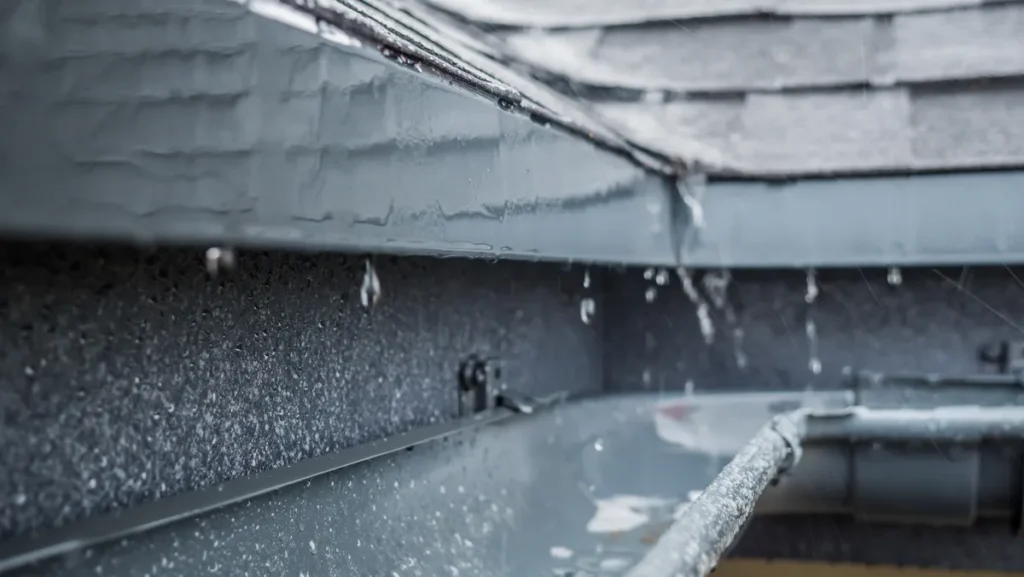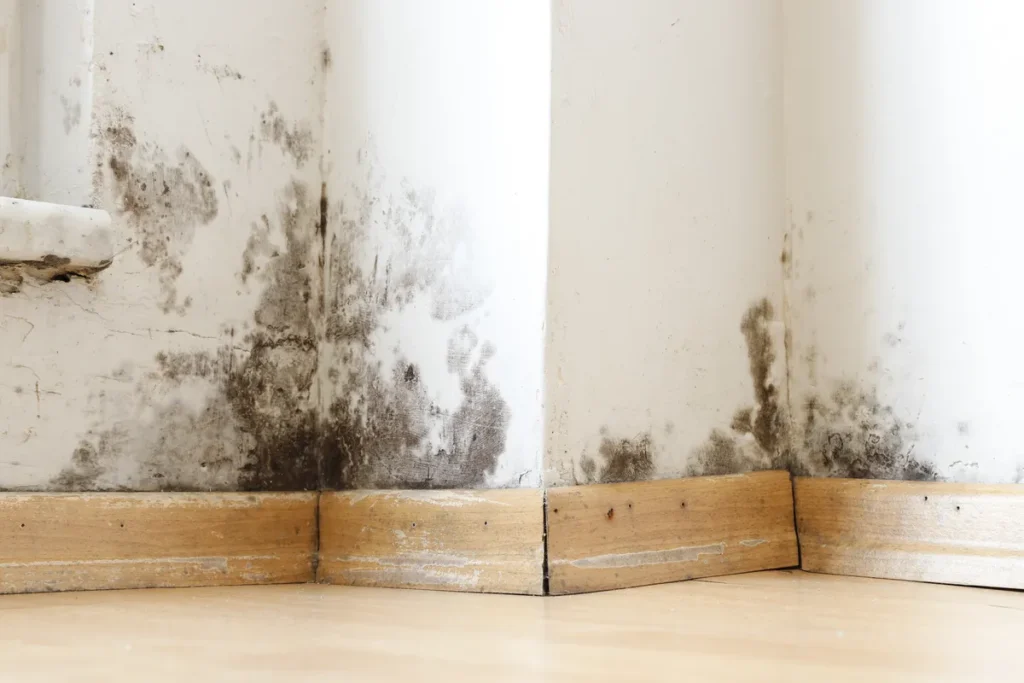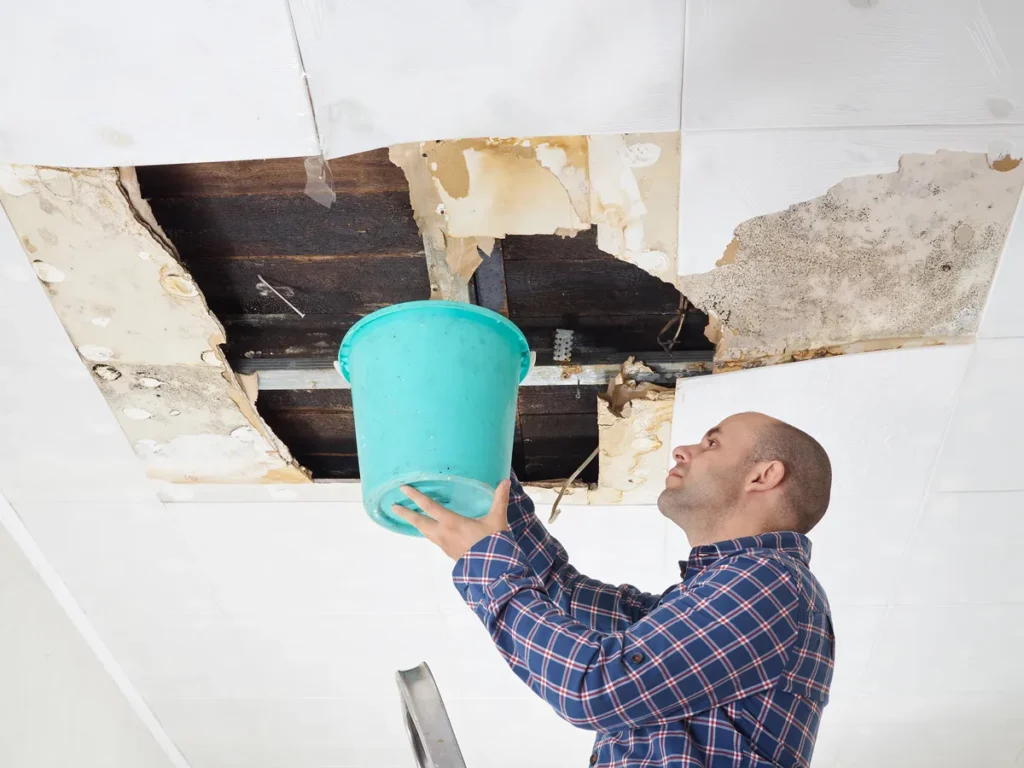How to Find a Roof Leak? (Signs, Fixes & More)
Posted: August 27, 2024
Roof leaks can turn into a homeowner’s nightmare if not detected and fixed promptly. This comprehensive guide will walk you through how to find a roof leak, the signs you should look for, and how to fix them. We aim to equip you with the knowledge you need to keep your home dry and secure, including:
- Understanding the causes of roof leaks
- Signs you have a roof leak
- Inspecting your roof for damage
- Benefits of addressing roof leaks promptly
- How to Fix a Roof Leak
- When to call a professional
🤔 Understanding the Causes of Roof Leaks

Before we get into how to find a roof leak, it’s essential to understand what causes them. Roof leaks can result from various issues, such as aging materials, poor installation, or severe weather conditions. Knowing the root cause can help you prevent future leaks.
Aging Materials
Roofs naturally deteriorate over time. Shingles can crack, curl, or lose their granules, all of which can lead to leaks. Regular maintenance can prolong the life of your roof, but eventually, it will need replacement.
Poor Installation
Improper installation of shingles, flashing, or vents can create vulnerabilities in your roof. These weak spots can allow water to seep in, especially during heavy rain or snow.
Severe Weather Conditions
Storms, high winds, and hail can damage your roof, leading to leaks. After a severe weather event, it’s crucial to inspect your roof for any signs of damage.
⚠️ 9 Signs You Have a Roof Leak
Identifying the signs of a roof leak early can save you from more extensive damage down the road. Here are some indicators that you might have a roof leak:
1. Water Stains on Ceilings and Walls
One of the most obvious signs of a roof leak is water stains on your ceilings or walls. These stains can be yellow or brown and often indicate that water has been seeping through your roof for some time. If left unaddressed, these stains can worsen and potentially lead to more significant water damage, compromising your home’s structural integrity.
2. Musty Odors
A musty smell in your attic or upper floors can signal mold or mildew growth due to a roof leak. Mold thrives in damp environments, so any unusual odors should be investigated immediately. Not only can these odors be unpleasant, but they can also pose health risks to you and your family, making prompt action essential.
3. Dripping Water
If you notice water dripping from the ceiling or down the walls during or after a rainstorm, you likely have a leak that needs urgent attention. This direct evidence of a leak can cause immediate damage to your walls and ceilings, leading to costly repairs if not fixed quickly.
4. Peeling Paint or Wallpaper
If you notice peeling paint or wallpaper, especially near ceilings or in corners, it could indicate moisture buildup from a roof leak. This peeling can further expose the underlying materials to moisture, leading to more extensive damage and the need for repairs or replacements.
5. Sagging Ceilings
A sagging ceiling can be a sign that water has accumulated, leading to structural damage. This should be assessed immediately, as a sagging ceiling may indicate that the weight of water is compromising the ceiling’s stability, potentially resulting in a collapse if not addressed.
6. Missing or Damaged Shingles
Visually inspecting your roof for missing, cracked, or curled shingles can help identify potential leak points. Shingles act as the first line of defense against the elements, and damage to them can lead to increased wear on your roof over time, necessitating repairs or a full roof replacement.
7. Increased Energy Bills
Unexpectedly high energy bills may be a sign of insulation damage from leaks, as your heating and cooling systems work harder to compensate. Leaks can create drafts or reduce your home’s energy efficiency, leading to higher costs and a less comfortable living environment.
8. Puddles or Wet Spots in the Attic
If you check your attic and find puddles or wet spots, this is a clear sign of a leak that needs to be addressed. These puddles can lead to significant water damage, mold growth, and even compromise the insulation in your attic, making it vital to act quickly.
9. Growth of Mold or Mildew

Visible mold or mildew inside your home, especially in areas close to the roof, can indicate an ongoing leak. This not only affects the aesthetics of your home but can also lead to serious health issues. Addressing the source of the leak and the mold growth is crucial for a safe living environment.
🔎 Inspecting Your Roof for Damage
Once you’ve identified the signs of a leak, the next step is to inspect your roof. This process involves both an interior and exterior examination.
Interior Inspection
Start by checking your attic. Look for signs of water damage, such as wet insulation, mold, or water stains. Use a flashlight to inspect dark corners and areas around vents or chimneys.
Exterior Inspection
For the exterior, you’ll need a sturdy ladder and a good pair of binoculars. Examine your roof for missing or damaged shingles, cracked flashing, and clogged gutters. Pay special attention to areas around chimneys, vents, and skylights.
Safety First
Always prioritize safety when inspecting your roof. If you’re uncomfortable or unsure about climbing up, it’s best to call a professional.
Common Areas Where Leaks Occur
Knowing where to look can make finding a roof leak much easier. Here are some common areas where leaks tend to occur:
Around Chimneys: Chimneys are a common source of leaks due to the complexity of their flashing. Check for cracks or gaps in the sealant around your chimney.
Near Skylights: Skylights can develop leaks if the flashing or sealant around them deteriorates. Inspect the areas around your skylights for any signs of water intrusion.
Roof Valleys: Roof valleys are where two slopes meet, creating a channel for water to flow. If the shingles in this area are damaged, water can easily seep in.
Using Water to Find a Roof Leak
When visual inspection isn’t enough, you can use water to help locate the leak. Here’s how:Enlist Help – You’ll need someone inside the house and someone on the roof.
Start Low and Work Up – Start by soaking the lower sections of the roof and gradually move higher.
Observe and Communicate – The person inside should watch for drips or wet spots and communicate with the person on the roof.
Precautions
Be cautious when using water, especially if the leak is near electrical fixtures. If you’re unsure, consult a professional.
✅ Benefits of Addressing Roof Leaks Promptly
Addressing roof leaks promptly offers several benefits:
Protects Your Home
Fixing leaks quickly is crucial as it prevents water damage that can compromise your home’s structure, insulation, and interiors. Prolonged exposure to moisture can weaken beams and support structures, leading to costly repairs.
Saves Money
Taking action early can save you significant amounts of money. Addressing leaks promptly not only prevents expensive repairs but also extends the life of your roofing and plumbing systems, ultimately saving on replacements.
Maintains Home Value
A well-maintained roof is a key factor in your home’s value. It enhances curb appeal, making your property more attractive to potential buyers, and signals to them that the home has been cared for and is less likely to incur future problems.
Improves Energy Efficiency
Sealing leaks effectively reduces energy loss by ensuring that your heating and cooling systems work efficiently. This leads to lower utility bills and a more comfortable living environment year-round.
Prevents Mold Growth
Quick repairs are essential in limiting moisture accumulation, which is a breeding ground for mold and mildew. By addressing leaks, you reduce the risk of health issues associated with mold exposure, such as respiratory problems and allergies.
Increases Safety
Addressing leaks as soon as they are detected can prevent potential hazards, such as ceiling collapses or electrical issues caused by water intrusion. Ensuring your home is safe and secure protects both your family and your property.
🛠️ How to Fix a Roof Leak
Fixing a roof leak is crucial to prevent water damage that can lead to costly repairs and compromised structural integrity. Addressing leaks promptly also helps maintain a safe and comfortable living environment.
Temporary Fixes for Roof Leaks

If you’ve identified a leak but can’t get it professionally repaired right away, here are some temporary fixes:
Tarp Method: Cover the affected area with a waterproof tarp. Secure it with nails or heavy objects to prevent water from entering.
Roofing Cement: Apply roofing cement to small cracks or holes. This can provide a short-term seal until a permanent repair is made.
Sealant: Use a waterproof sealant to patch up leaks around vents, chimneys, or skylights. Ensure the area is dry before applying the sealant.
Long-Term Solutions for Roof Leaks
For a permanent fix, consider the following solutions:
Roof Replacement: If your roof is old or extensively damaged, a complete replacement may be necessary. This ensures a long-lasting solution to prevent future leaks.
Professional Repair: Hire a professional roofing company to address the specific issue. They have the expertise and tools to provide a durable fix.
Regular Maintenance: Regular roof maintenance can help catch potential problems before they become significant issues. Schedule annual inspections to keep your roof in top shape.
👨🔧 When to Call a Professional
While some minor leaks can be fixed with DIY methods, there are times when you should call a professional:
- Extensive Damage: If the damage is extensive or covers a large area, it’s best to consult a professional for a comprehensive repair.
- Safety Concerns: If you’re uncomfortable or unsure about inspecting or repairing your roof, prioritize your safety and call a professional.
- Recurrent Leaks: If you’ve tried temporary fixes and the leaks keep coming back, it’s time to seek expert help for a long-term solution.
Preventing Future Roof Leaks
Prevention is always better than a cure. Here are some tips to prevent future leaks:
Clean Gutters: Ensure your gutters are clean and free of debris. Clogged gutters can cause water to back up and seep under your roof.
Trim Overhanging Branches: Overhanging branches can damage your shingles and create entry points for water. Keep trees trimmed away from your roof.
Inspect Flashing: Regularly inspect the flashing around chimneys, vents, and skylights. Replace or repair any damaged flashing to maintain a watertight seal.
🙌 Protect Your Home with Reliable Roofing Solutions from SMR HomePros
At SMR HomePros, we understand the importance of a reliable roof. Our family-owned, locally-operated company offers exceptional roofing services backed by industry-leading warranties. We prioritize honest communication, thorough customer education, and meticulous workmanship to ensure your home remains protected.
Ready to safeguard your home from roof leaks? Reach out to our expert team at SMR HomePros for a free estimate and experience hassle-free roofing solutions. Contact us today and keep your home secure and dry.
